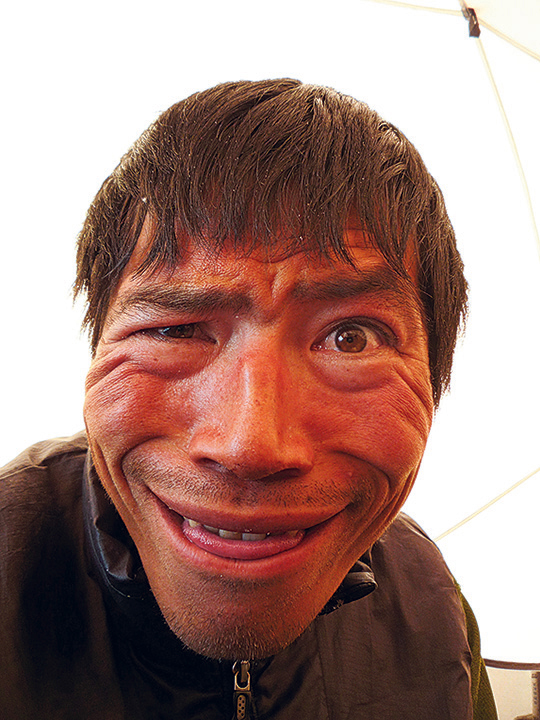 “There was no pathos,” Katsutaka Yokoyama says of their sometimes-frightening first ascent of I-TO (ED+: WI5 M6), the southeast face of Canada’s Mt. Logan (5959m), “only laughter.” [Photo] Katsutaka Yokoyama collection
“There was no pathos,” Katsutaka Yokoyama says of their sometimes-frightening first ascent of I-TO (ED+: WI5 M6), the southeast face of Canada’s Mt. Logan (5959m), “only laughter.” [Photo] Katsutaka Yokoyama collection
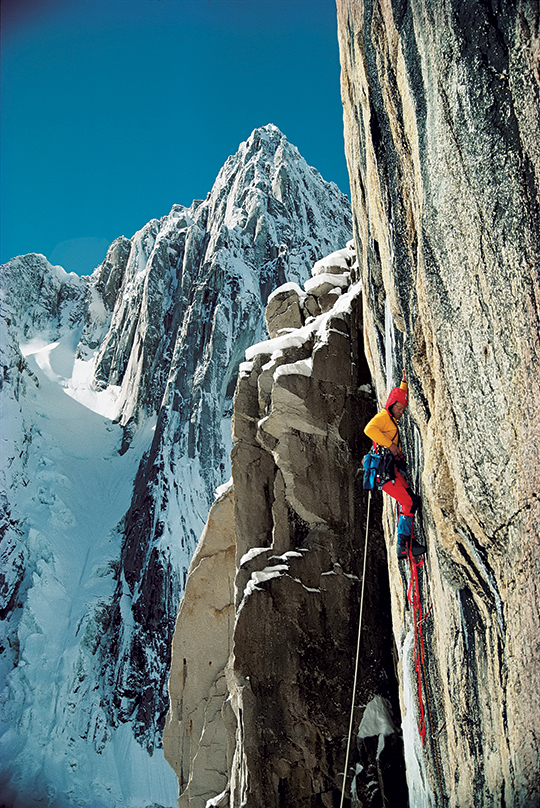
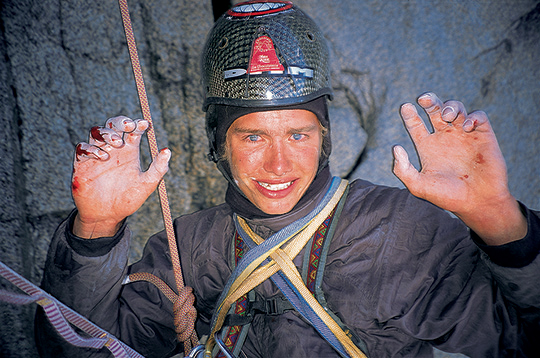 Pain! Leo Houlding moments after shattering his right talus on the east face of Cerro Torre. [Photo] Kevin Thaw/Leo Houlding collection
Pain! Leo Houlding moments after shattering his right talus on the east face of Cerro Torre. [Photo] Kevin Thaw/Leo Houlding collection
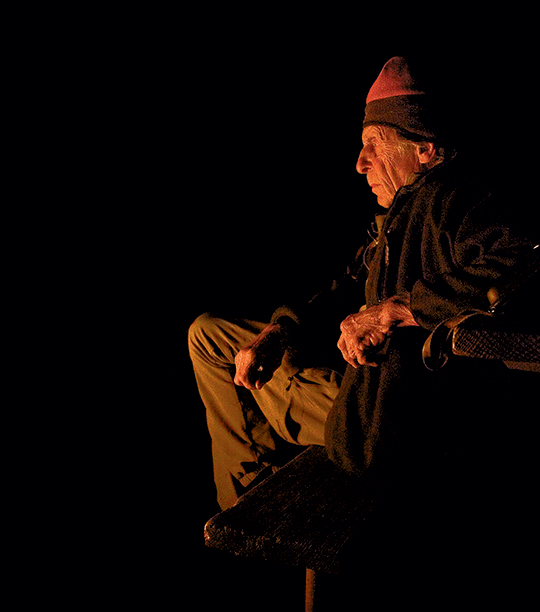
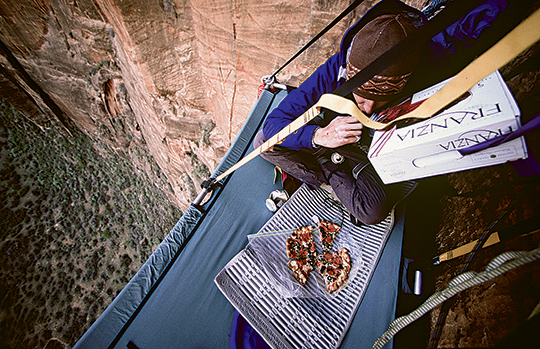 [Photo] Dave Campbell
[Photo] Dave Campbell
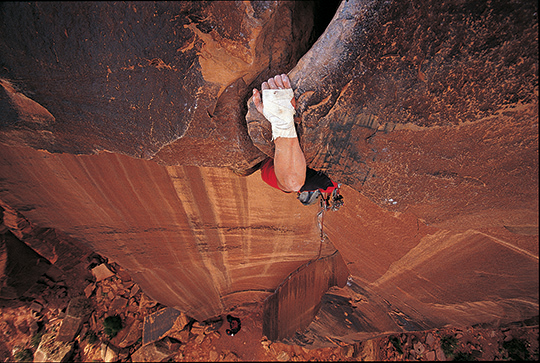 [Photo] Rob Frost
[Photo] Rob Frost
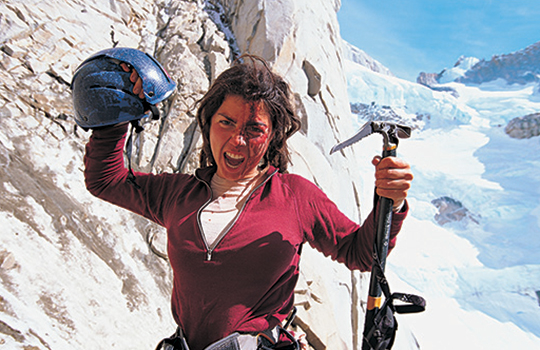 Crystal Davis-Robbins, first ascent, Bloody Luck (5.11d A1 M4, 650m), Domo Blanco (2507m), Patagonia, Argentina. Davis-Robbins accomplished the FA with Jon Walsh and Chris Brazeau on January 13, taking a rock to the forehead on the approach, then another to the hel- met at the first belay. Also on her trip, she established Fingerlicious (5.11b/c M4, 500m) on Quatros Dedos with Walsh and Brazeau and The Art of War (V 5.12a A2, 1000m) on Aguja de la S with Ryan Nelson. [Photo] Jon Walsh
Crystal Davis-Robbins, first ascent, Bloody Luck (5.11d A1 M4, 650m), Domo Blanco (2507m), Patagonia, Argentina. Davis-Robbins accomplished the FA with Jon Walsh and Chris Brazeau on January 13, taking a rock to the forehead on the approach, then another to the hel- met at the first belay. Also on her trip, she established Fingerlicious (5.11b/c M4, 500m) on Quatros Dedos with Walsh and Brazeau and The Art of War (V 5.12a A2, 1000m) on Aguja de la S with Ryan Nelson. [Photo] Jon Walsh
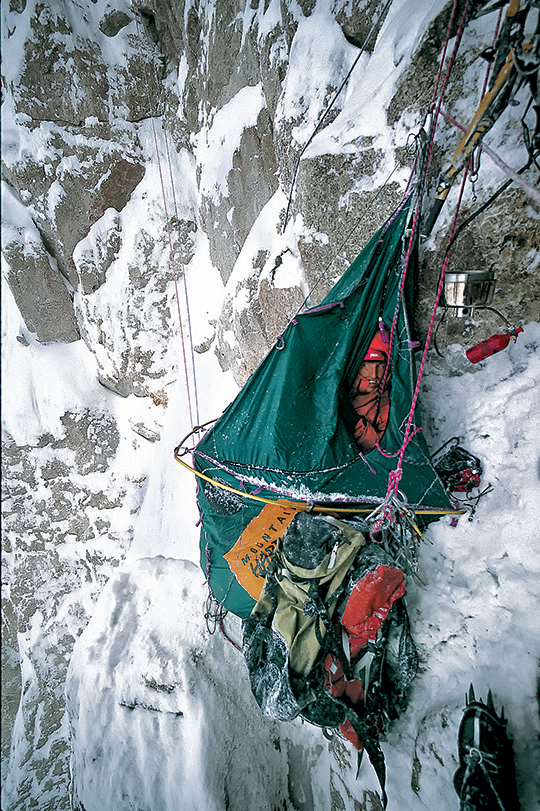 Don’t try this at home. Kenton Cool and a vertically pitched tent on the second ascent of the Denali Diamond (Alaska Grade 6 5.9 A3, 7,800′, Becker-Graage, 1983), Denali. [Photo] Ian Parnell
Don’t try this at home. Kenton Cool and a vertically pitched tent on the second ascent of the Denali Diamond (Alaska Grade 6 5.9 A3, 7,800′, Becker-Graage, 1983), Denali. [Photo] Ian Parnell
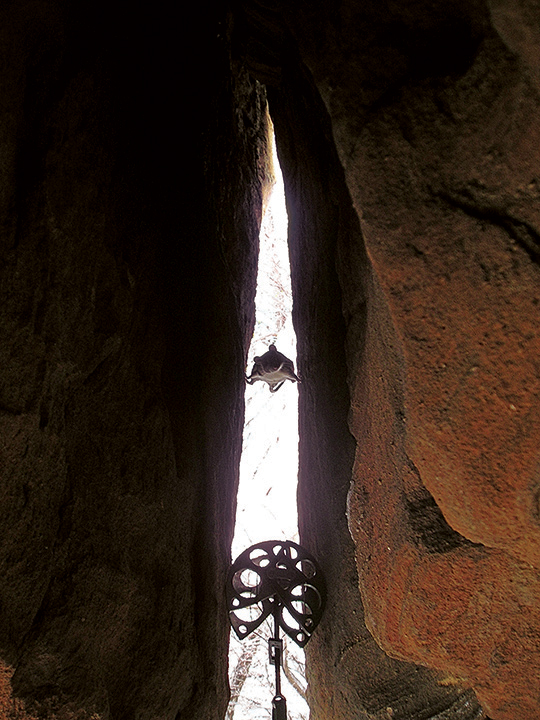 A Red River Gorge wood rat stemming the offwidth roof boulder problem When Doves Cry (V4, 30′). [Photo] Bart Bledsoe
A Red River Gorge wood rat stemming the offwidth roof boulder problem When Doves Cry (V4, 30′). [Photo] Bart Bledsoe
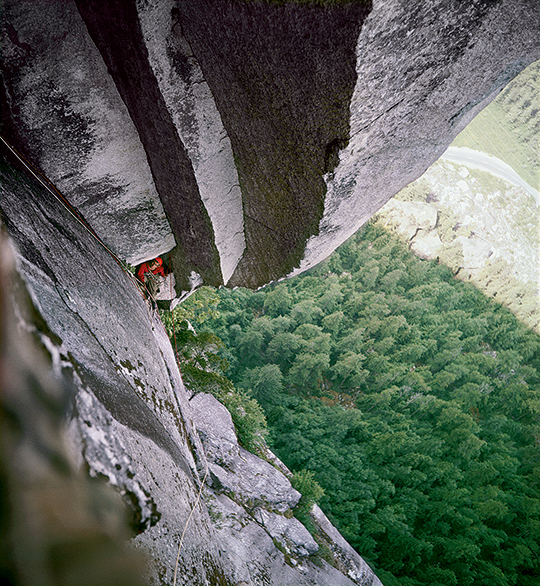 Jim Baldwin in the Roman Chimneys during the Grand Wall first ascent. Cooper recalls using “pitons made by the local blacksmith (which weighed in at almost a pound apiece).” [Photo] Ed Cooper
Jim Baldwin in the Roman Chimneys during the Grand Wall first ascent. Cooper recalls using “pitons made by the local blacksmith (which weighed in at almost a pound apiece).” [Photo] Ed Cooper
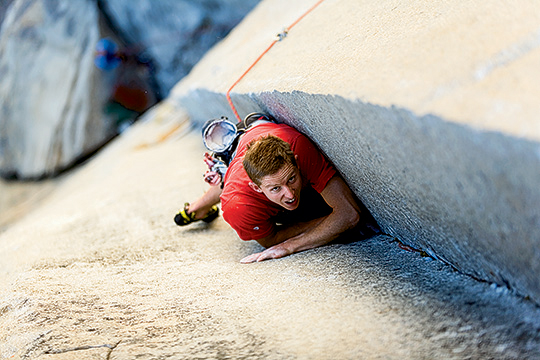 The crux of the Free Nose: Tommy Caldwell works the entry moves into the Changing Corners pitch. From a high point accessed by another crack system, he clips a bolt (placed by Brooke Sandahl in 1993 while working on the Free Nose with Lynn Hill), then down climbs and works his way into the corner. (Rodden, who is five feet tall, was forced to access the corner twenty feet lower than Caldwell did.) Caldwell calls the moves that follow “unlike anything I’ve done.” Ivo Ninov and Thomas Huber bolted a new variation to the Changing Corners pitch in the autumn of 2005, shortly after Caldwell and Rodden’s climb. This variation continues up from the Sandahl bolt to a new bolted belay, approximately eighty feet from the last anchors. The next moves, off the belay, are protected by another bolt and go at V8. Another twenty feet of climbing leads to the normal belay at the top of the Changing Corners pitch. The variation allows one to avoid the crux of the Free Nose. [Photo] Corey Rich
The crux of the Free Nose: Tommy Caldwell works the entry moves into the Changing Corners pitch. From a high point accessed by another crack system, he clips a bolt (placed by Brooke Sandahl in 1993 while working on the Free Nose with Lynn Hill), then down climbs and works his way into the corner. (Rodden, who is five feet tall, was forced to access the corner twenty feet lower than Caldwell did.) Caldwell calls the moves that follow “unlike anything I’ve done.” Ivo Ninov and Thomas Huber bolted a new variation to the Changing Corners pitch in the autumn of 2005, shortly after Caldwell and Rodden’s climb. This variation continues up from the Sandahl bolt to a new bolted belay, approximately eighty feet from the last anchors. The next moves, off the belay, are protected by another bolt and go at V8. Another twenty feet of climbing leads to the normal belay at the top of the Changing Corners pitch. The variation allows one to avoid the crux of the Free Nose. [Photo] Corey Rich
 [Photo] Louis Arevalo/Tandem Stills + Motion
[Photo] Louis Arevalo/Tandem Stills + Motion
 [Photo] Andrew Burr
[Photo] Andrew Burr
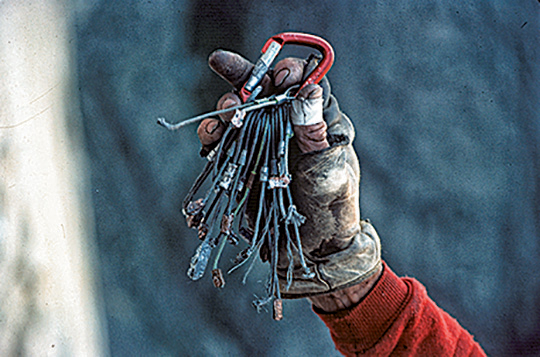 Copperheads after a particularly exciting pitch during the first ascent of The Big Chill (VI 5.9 A4) in 1988. The route, on the right side of Half Dome, was the first to employ the PDH (“Pretty Damn Hard”) and NSB (“Not So Bad”) ratings–a response to local debate about the possibility of A5. [Photo] Jim Bridwell collection
Copperheads after a particularly exciting pitch during the first ascent of The Big Chill (VI 5.9 A4) in 1988. The route, on the right side of Half Dome, was the first to employ the PDH (“Pretty Damn Hard”) and NSB (“Not So Bad”) ratings–a response to local debate about the possibility of A5. [Photo] Jim Bridwell collection
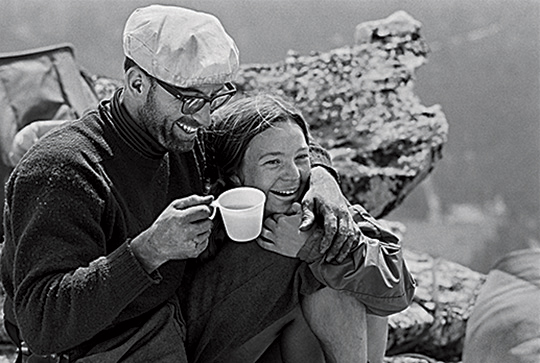 Royal and Liz Robbins [Photo] Glen Denny
Royal and Liz Robbins [Photo] Glen Denny
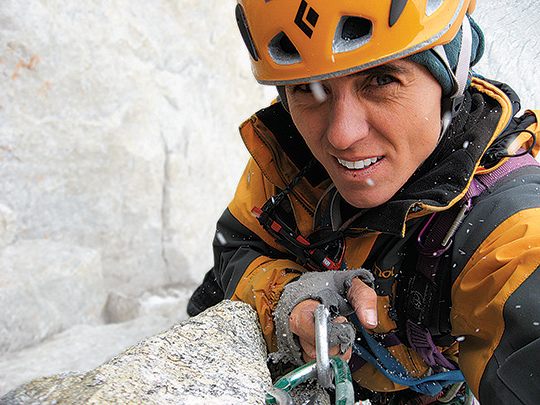 Silvia Vidal on Pitch 11 of her new route, Life Is Lilac (VI A4+ 6a, 870m), Shipton Spire (5885m), Karakoram, Pakistan, which she completed solo over twenty-one days in July 2007. [Photo] Silvia Vidal
Silvia Vidal on Pitch 11 of her new route, Life Is Lilac (VI A4+ 6a, 870m), Shipton Spire (5885m), Karakoram, Pakistan, which she completed solo over twenty-one days in July 2007. [Photo] Silvia Vidal
 The sometimes-high price of climbing Everest “by fair means”: Stephen Venables’ Frostbitten and desiccated toes, three months after he became the first Briton to summit Everest without supplementary oxygen, via new route on May 12, 1988. A surgeon soon amputated four of these dead black digits; only the little toe survived. [Photo] Stephen Venables
The sometimes-high price of climbing Everest “by fair means”: Stephen Venables’ Frostbitten and desiccated toes, three months after he became the first Briton to summit Everest without supplementary oxygen, via new route on May 12, 1988. A surgeon soon amputated four of these dead black digits; only the little toe survived. [Photo] Stephen Venables
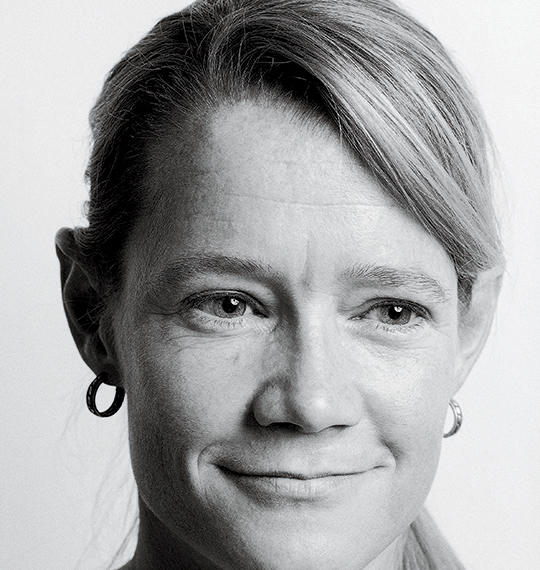 Until I found God, climbing was my only religion. Initially, I was drawn to climbing because I knew nothing about it. Although I was afraid of heights, I wanted to challenge myself, and alpine climbing, especially in the winter in the Rockies, became my passion. Surviving my first forced bivouac, my first avalanche and my first storm without food accelerated my learning curve. After three winters, I decided to see what I could learn from other mountain ranges around the world. As a kid, I never dreamed I would visit countries like Peru, Nepal and India, but climbing brought me to these places and more, and interacting with their cultures helped me develop an open mind. But what meant the most was the intense bond that formed between me and my partners when we worked together through incredible hardships. My major motivation now is to learn new skills as I push my technical abilities. Climbing at my limits keeps me humble. I am trying to lose the judgmental attitude and focus instead on my connections with other people and the environment. I have finally reached a place where I can be a driven climber, but content at the same time. Though I am still looking for the next cool line to do, that search no longer defines who I am. [Photo] Giulio Malfer
Until I found God, climbing was my only religion. Initially, I was drawn to climbing because I knew nothing about it. Although I was afraid of heights, I wanted to challenge myself, and alpine climbing, especially in the winter in the Rockies, became my passion. Surviving my first forced bivouac, my first avalanche and my first storm without food accelerated my learning curve. After three winters, I decided to see what I could learn from other mountain ranges around the world. As a kid, I never dreamed I would visit countries like Peru, Nepal and India, but climbing brought me to these places and more, and interacting with their cultures helped me develop an open mind. But what meant the most was the intense bond that formed between me and my partners when we worked together through incredible hardships. My major motivation now is to learn new skills as I push my technical abilities. Climbing at my limits keeps me humble. I am trying to lose the judgmental attitude and focus instead on my connections with other people and the environment. I have finally reached a place where I can be a driven climber, but content at the same time. Though I am still looking for the next cool line to do, that search no longer defines who I am. [Photo] Giulio Malfer
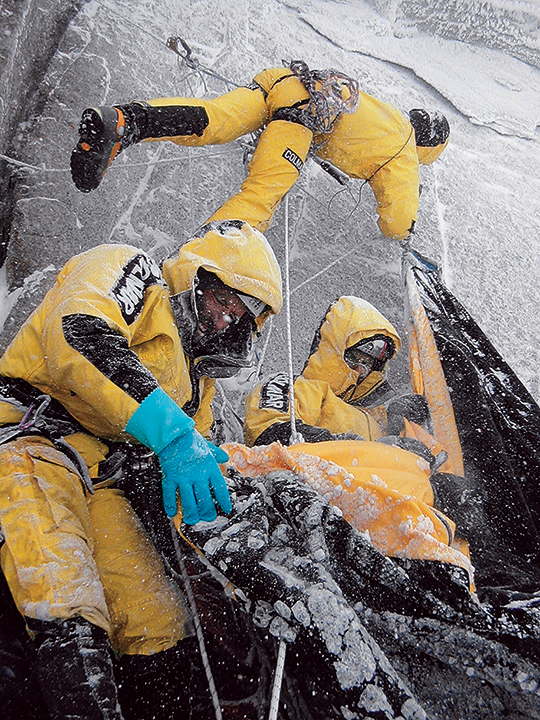 Mauro Giovanazzi, Walter Gobbi, and Paolo Calza building character on the east face of Cerro Torre. [Photo] Ermanno Salvaterra
Mauro Giovanazzi, Walter Gobbi, and Paolo Calza building character on the east face of Cerro Torre. [Photo] Ermanno Salvaterra
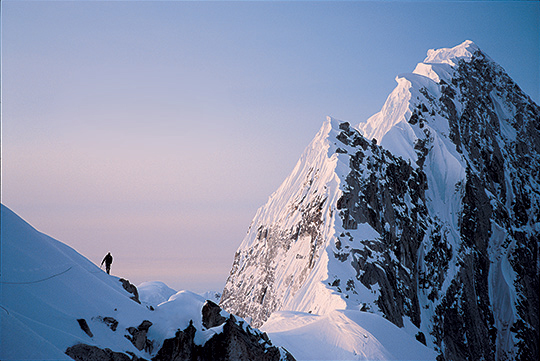 Markus Stofer on Mt. Huntington’s French (Northwest) Ridge in 2003. Stofer, Bruno Hasler, Iwan Wolf and Urs Stocker made a twenty-four-hour “speed ascent of [most of] the French Ridge,” as Hasler noted in The American Alpine Journal, turning around fifty meters below the summit because of high objective hazards. When Kelly Cordes and Scott DeCapio completed the first one-day ascent of the mountain in 1998, Cordes commented, “I now under- stood why so many people stop at, ahem, “the end of the difficulties.'” [Photo] Bruno Hasler
Markus Stofer on Mt. Huntington’s French (Northwest) Ridge in 2003. Stofer, Bruno Hasler, Iwan Wolf and Urs Stocker made a twenty-four-hour “speed ascent of [most of] the French Ridge,” as Hasler noted in The American Alpine Journal, turning around fifty meters below the summit because of high objective hazards. When Kelly Cordes and Scott DeCapio completed the first one-day ascent of the mountain in 1998, Cordes commented, “I now under- stood why so many people stop at, ahem, “the end of the difficulties.'” [Photo] Bruno Hasler
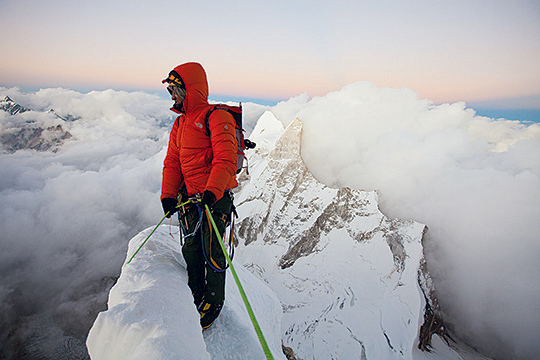 Renan Ozturk descends from Meru. “Meru in the Hindu tradition holds the heavens and earth along a fixed plane,” says Dr. Meera Baindur. Some Hindus and Buddhists believe the “Meru” of the myths has no physical location; others identify it as Mt. Kailash instead. In Landscapes of the Sacred, Belden C. Lane writes: “It lingers yet in imagination and fragment of dream, the abode where mountains finally reach their greatest height. What is this inner need we humans have for the mountain seen within?… Mt. Meru, for Tibetan Buddhists, is…80,000 miles high, reaching to the corners of the earth. Yet its co- ordinates are those of the spirit alone, plotted by a cartographer Ptolemy never knew.” [Photo] Jimmy Chin
Renan Ozturk descends from Meru. “Meru in the Hindu tradition holds the heavens and earth along a fixed plane,” says Dr. Meera Baindur. Some Hindus and Buddhists believe the “Meru” of the myths has no physical location; others identify it as Mt. Kailash instead. In Landscapes of the Sacred, Belden C. Lane writes: “It lingers yet in imagination and fragment of dream, the abode where mountains finally reach their greatest height. What is this inner need we humans have for the mountain seen within?… Mt. Meru, for Tibetan Buddhists, is…80,000 miles high, reaching to the corners of the earth. Yet its co- ordinates are those of the spirit alone, plotted by a cartographer Ptolemy never knew.” [Photo] Jimmy Chin
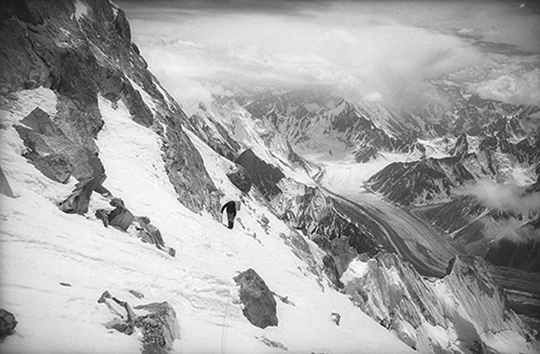 August 6, 1958: Carlo Mauri descends from the summit of Gasherbrum IV after making the first ascent. [Photo] Walter Bonatti
August 6, 1958: Carlo Mauri descends from the summit of Gasherbrum IV after making the first ascent. [Photo] Walter Bonatti
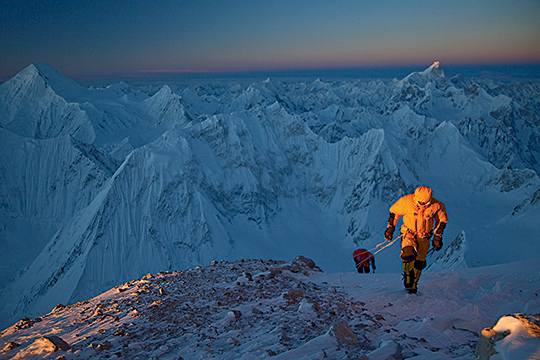 Denis Urubko and Simone Moro at 7600 meters on Gasherbrum II (8035m), February 2, 2011. For more on their climb, see “First Winter Ascent of an 8000m Peak in Pakistan” on alpinist.com/newswire and the May issue of Outside. [Photo] Cory Richards
Denis Urubko and Simone Moro at 7600 meters on Gasherbrum II (8035m), February 2, 2011. For more on their climb, see “First Winter Ascent of an 8000m Peak in Pakistan” on alpinist.com/newswire and the May issue of Outside. [Photo] Cory Richards
 Out of food, out of fuel, Doug Tompkins retreats from the southwest buttress to corral another sheep for more attempts. The team enjoyed five days of good weather during their two months at the base of the mountain and spent thirty-one days in a snow cave. Tompkins would go on to found The North Face, and later, Esprit, but his early journeys in Patagonia eventually lured him back: he and his wife, Kris, now invest their time and resources in the largest non-governmental land conservation effort in Chile and Argentina. [Photo] Lito Tejada-Flores
Out of food, out of fuel, Doug Tompkins retreats from the southwest buttress to corral another sheep for more attempts. The team enjoyed five days of good weather during their two months at the base of the mountain and spent thirty-one days in a snow cave. Tompkins would go on to found The North Face, and later, Esprit, but his early journeys in Patagonia eventually lured him back: he and his wife, Kris, now invest their time and resources in the largest non-governmental land conservation effort in Chile and Argentina. [Photo] Lito Tejada-Flores
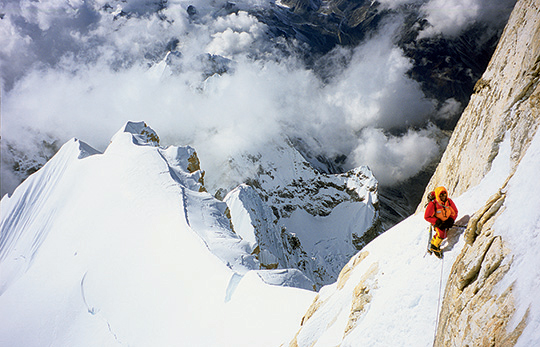 Sergey Kofanov at 7500 meters during the first ascent of The West Pillar (VI WI4+ M5 80 degrees, 3000m) Jannu (7710m), Himalaya, Nepal. Kofanov and Valery Babanov accomplished the climb October 14-23, 2007. It was the first new route opened on the mountain in alpine style. See article on page 72. [Photo] Valery Babanov
Sergey Kofanov at 7500 meters during the first ascent of The West Pillar (VI WI4+ M5 80 degrees, 3000m) Jannu (7710m), Himalaya, Nepal. Kofanov and Valery Babanov accomplished the climb October 14-23, 2007. It was the first new route opened on the mountain in alpine style. See article on page 72. [Photo] Valery Babanov
 The east and north faces of the Matterhorn at dawn. Valais Alps, Switzerland. [Photo] Mario Colonel
The east and north faces of the Matterhorn at dawn. Valais Alps, Switzerland. [Photo] Mario Colonel
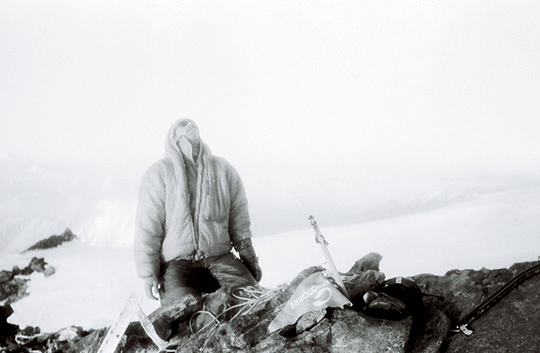 Steve House on the summit of Nanga Parbat (8125m). In September, House and partner Vince Anderson climbed the Central Pillar of the Rupal Face (5.9 M5 X WI4, 4100m) in eight days round-trip. They descended via the Messner Route. Reinhold and Gunther Messner made the first ascent of the Rupal Face–famous as one of the biggest, if not the biggest, walls in the world–in 1970; Gunther disappeared during the descent. A few weeks before House and Anderson’s 2005 climb, Tomaz Humar added to the face’s infamy when he was evacuated from ca. 5700 meters in the highest-altitude helicopter rescue ever mounted. [Photo] Vince Anderson
Steve House on the summit of Nanga Parbat (8125m). In September, House and partner Vince Anderson climbed the Central Pillar of the Rupal Face (5.9 M5 X WI4, 4100m) in eight days round-trip. They descended via the Messner Route. Reinhold and Gunther Messner made the first ascent of the Rupal Face–famous as one of the biggest, if not the biggest, walls in the world–in 1970; Gunther disappeared during the descent. A few weeks before House and Anderson’s 2005 climb, Tomaz Humar added to the face’s infamy when he was evacuated from ca. 5700 meters in the highest-altitude helicopter rescue ever mounted. [Photo] Vince Anderson
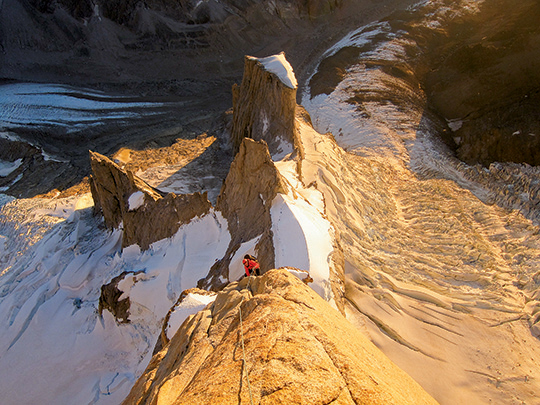 Jason Kruk during the first “fair means” ascent of the Southeast Ridge of Cerro Torre. To avoid Maestri’s bolts, he and Kennedy climbed the cracks to the left of the 1970 line, continuing the attempts by Ermanno Salvaterra and Mauro Mabboni in 1999; Zack Smith and Josh Wharton in 2007; and Chris Geisler and Kruk in 2011. [Photo] Hayden Kennedy
Jason Kruk during the first “fair means” ascent of the Southeast Ridge of Cerro Torre. To avoid Maestri’s bolts, he and Kennedy climbed the cracks to the left of the 1970 line, continuing the attempts by Ermanno Salvaterra and Mauro Mabboni in 1999; Zack Smith and Josh Wharton in 2007; and Chris Geisler and Kruk in 2011. [Photo] Hayden Kennedy
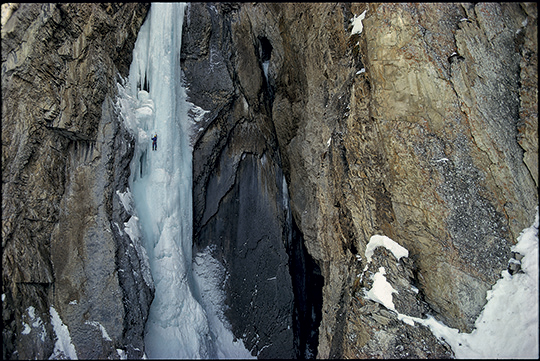 Barry Blanchard soloing on Whiteman Falls (WI6), Rockies, Canada, 1990. “Back then we identified a condition that we’ve exploited: breakup courage. Whoever was going through it leads, especially the dangerous stuff.” A year later Blanchard managed the first integral ascent of the 4,500-foot north face of Nepal’s Kusum Kanguru (20,895′) in a three-day effort that would prove one of the most trying of his career. [Photo] Barry Blanchard collection
Barry Blanchard soloing on Whiteman Falls (WI6), Rockies, Canada, 1990. “Back then we identified a condition that we’ve exploited: breakup courage. Whoever was going through it leads, especially the dangerous stuff.” A year later Blanchard managed the first integral ascent of the 4,500-foot north face of Nepal’s Kusum Kanguru (20,895′) in a three-day effort that would prove one of the most trying of his career. [Photo] Barry Blanchard collection
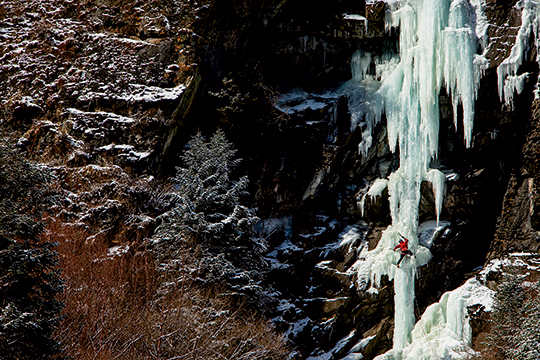
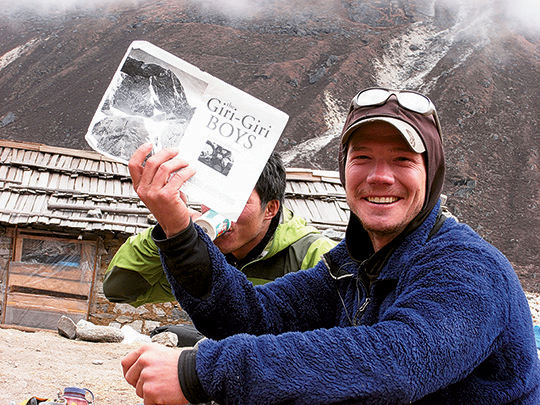 Freddie Wilkinson holding up the proofs of the original issue 26 in October 2008, shortly after he and fellow contributer Katsutaka Yokoyama (hiding in the background) learned that Alpinist had ceased publication in the midst of printing their articles. Wilkinson, Ben Gilmore and Kevin Mahoney had just completed their New Hampshire Route (AI5+ R/X, 1000′), and Yokoyama and Yusuke Sato had just finished their direct-line attempt, on the north face of Kantega (6779m), Nepal. Yokoyama’s feature (shown in the photo), “The Giri-Giri Boys,” now appears on page 58 of issue 26. Informed of Alpinist‘s revival, Yokoyama responded: “My article is still yours.” [Photo] Nick Bullock
Freddie Wilkinson holding up the proofs of the original issue 26 in October 2008, shortly after he and fellow contributer Katsutaka Yokoyama (hiding in the background) learned that Alpinist had ceased publication in the midst of printing their articles. Wilkinson, Ben Gilmore and Kevin Mahoney had just completed their New Hampshire Route (AI5+ R/X, 1000′), and Yokoyama and Yusuke Sato had just finished their direct-line attempt, on the north face of Kantega (6779m), Nepal. Yokoyama’s feature (shown in the photo), “The Giri-Giri Boys,” now appears on page 58 of issue 26. Informed of Alpinist‘s revival, Yokoyama responded: “My article is still yours.” [Photo] Nick Bullock
 The southern aspects of Denali (20,320′), Alaska Range, Alaska, as seen from above the Ruth Amphitheater. The Athabaskan tribe had originally dubbed it “Denali” (“the High One”). In 1896 prospector William A. Dickey renamed it “Mt. McKinley” after then-presidential nominee William Mckinley. Today it is Denali once more, crown jewel of the Alaska Range and of North American mountaineering. [Photo] Bradford Washburn
The southern aspects of Denali (20,320′), Alaska Range, Alaska, as seen from above the Ruth Amphitheater. The Athabaskan tribe had originally dubbed it “Denali” (“the High One”). In 1896 prospector William A. Dickey renamed it “Mt. McKinley” after then-presidential nominee William Mckinley. Today it is Denali once more, crown jewel of the Alaska Range and of North American mountaineering. [Photo] Bradford Washburn































































